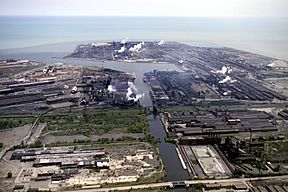Indiana Harbor and Ship Canal facts for kids
Quick facts for kids Indiana Harbor Canal |
|
|---|---|

Aerial view of Indiana Harbor and Ship Canal
|
|
| Location | East Chicago, Indiana |
| Country | United States |
| Coordinates | 41°40′06″N 87°26′25″W / 41.6684°N 87.4402°W |
| Specifications | |
| Length | 6.75 miles (10.86 km) |
| Locks | None |
| Status | Open |
| Geography | |
| Start point | Lake Michigan |
| End point | Grand Calumet River |
| Branch(es) | Grand Calumet River Branch Lake George Branch |
The Indiana Harbor and Ship Canal is a man-made waterway in East Chicago, Indiana. It connects the Grand Calumet River to Lake Michigan. This important canal also works as a busy harbor for ships.
The canal has two main parts, or branches. One is called the Lake George Branch, which is about 1.25 miles (2 kilometers) long. The other is the Grand Calumet River Branch, which is about 2 miles (3.2 kilometers) long. These two branches join together to form the main Indiana Harbor Canal.
Ships enter the harbor from Lake Michigan. The outer part of the harbor is protected by special walls called bulkheads. These walls have lights to guide ships safely. The inner part of the harbor is the canal itself. In 2002, Indiana Harbor was one of the busiest harbors in the United States. It handled about 13.3 million short tons (12 million metric tons) of cargo that year. The U.S. Army Corps of Engineers helps maintain this important waterway.
Contents
History of the Canal
The Indiana Harbor and Ship Canal was built a long time ago, starting in 1901. A company called Inland Steel Company played a big role in its creation. In 1901, Inland Steel was offered free land if they built a large steel mill there. They agreed to build a mill that would cost at least one million dollars.
Building the canal and harbor helped the steel mill and other businesses grow. A railway was also built to connect this area to other train lines. This railway is still known today as the Indiana Harbor Belt Railroad. Near the harbor, you can also find Marktown, which was a special community planned for workers.
What the Canal is Used For
The Indiana Harbor and Canal is located in a very industrial area. This means there are many factories and businesses nearby.
Manufacturing and Trade
Many large companies use the canal. For example, Cleveland-Cliffs has two big steel facilities here. There's also a large oil refinery belonging to BP nearby in Whiting.
The canal is super important for transporting materials. Ships bring things like iron ore (which looks like small pellets), limestone, and coke to the steel mills. These materials come from mines and quarries around the Great Lakes. Other goods moved through the canal include gypsum, steel products, cement, and petroleum products.
The Indiana Harbor is the busiest commercial harbor on Lake Michigan. It's also the second busiest among all 55 federal commercial harbors on the Great Lakes. This shows how vital it is for moving goods and supporting industries.
Environmental Challenges
The Indiana Harbor Canal faces some big environmental problems. Most of the water in the canal comes from industrial waste or stormwater runoff. Over many years, the canal has become polluted with harmful chemicals. These include polychlorinated biphenyls (PCBs), polycyclic aromatic hydrocarbons (PAHs), and heavy metals.
Pollution and Dredging
Because of this pollution, the canal is part of the EPA's Grand Calumet River Area of Concern. This means it's a place with serious environmental issues. The polluted mud and dirt at the bottom of the canal, called sediment, has not been removed since 1972. This is because there was no safe place to put the contaminated sediment.
This buildup of sediment makes the canal shallower. This makes it harder for large ships to pass through. It also means that pollution from the canal can spread into Lake Michigan. Each year, thousands of pounds of harmful substances like chromium, lead, and PCBs can reach the lake from the canal.
Cleaning Up the Canal
To fix this problem, the U.S. Army Corps of Engineers and the East Chicago Waterway Management District started a cleanup plan. They decided to build a special place called a confined disposal facility (CDF). This facility is designed to safely hold the contaminated sediment that will be removed from the canal.
Construction of this facility began in 2002. The plan was to start dredging (removing the sediment) once the CDF was ready. Dredging finally began in 2012, forty years after the last cleanup. The first phase of dredging was finished in 2020. The second phase started in 2021 and is expected to continue until 2023. This project aims to make the harbor deep enough for ships again and reduce pollution in Lake Michigan.

